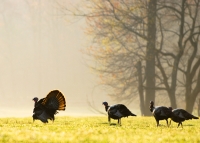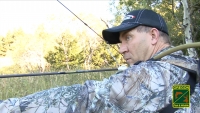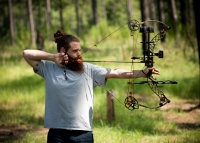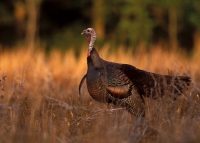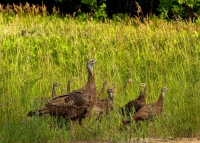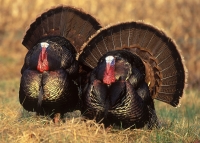
Turkey hunting techniques
Finding turkeys
Turkey behavior changes over a hunting season. So it helps to think a bit like a turkey when planning your strategy for finding turkeys and setting up your hunt.
Spring turkey behavior
By the time hunting season opens on April 15, most of the hen turkeys have already bred. Though they may not be sitting on their nests quite yet. This keeps tom turkeys close to the hens during the first few weeks of the season, making it difficult for hunters to lure toms away from hens and into shooting range.
If tom numbers are low, they are less likely to leave their strutting ground and the hens in one area to check out a random hen (you) calling in the distance. If tom ratios are high and the competition to breed is intense, hunters can set up farther away and still call in a tom. If hens are sparse, it’s not uncommon for an eager tom to travel a quarter-mile or more to check out your call.
As the season progresses and hens begin incubating their eggs, toms often go in search of hens that may have missed being bred, or may have lost a clutch and need to breed again. When these toms are on the move, they’ll be more susceptible to your calling.
During the last couple weeks of the spring season, toms largely concentrate on eating, which means calling in food-rich habitats can be productive. Newly sprouting grass seeds and some berries, fruits and insects are key food sources. Often times the biggest toms are taken by hunters late in the season, once all the hens have begun raising their broods.
Fall turkey
In late summer and early fall, turkeys gather in family units. By October, you might see a flock of 50 turkeys consisting of multiple family units. By December, a single flock of 200 or more turkeys is not uncommon.
When Oregon’s fall turkey season begins in October, turkeys are largely feeding on insects, fruits, berries, and some grasses and weeds. Flocks are easy to spot and their daily movements are patternable.
As long as there’s food in the area, turkeys will cover the same ground every day, at nearly the same time. If you study this pattern before your hunt, you can plan where to set up and wait for the birds to come by. Ground blinds are popular for this kind of hunting – it’s nice to have a comfortable place to sit while waiting for turkeys to approach.
Turkeys can be called in the fall, but calling may not be as effective as during the spring breeding season. Both tom and hen turkeys can be harvested during Oregon’s fall season.
Locating turkeys
Once you’ve arrived at your hunting location, you can pinpoint a turkey’s location by using a locator call -- an owl, crow or even peacock call -- to elicit a return gobble from a tom. You’re not trying to call a bird to you, you’re just trying to locate a bird by getting a turkey to gobble back at you.
Do this right before dark the night before your hunt when turkeys are on the roost (resting in trees for the night) so you'll know where to set up the next morning.
Or, use a locator call before daylight while turkeys are still on the roost. Once a tom gobbles back, pinpoint his location and move to a good location to set up. Once you’re settled, start using your turkey calls to lure in a tom.
Setting up to hunt
Turkeys don’t like to fly at night, so the best time to get set up for your hunt is either right before dark the day before your hunt. Or before daylight the day of your hunt.
Once you’ve located a tom, either seeing it or by hearing it gobble, it’s time to make a plan. The goal is to get close enough to call in a tom, without letting him know you’re there.
Be in place before daylight
If you’ve been out the night before and used a locator call to find a tom on his roost, get to your designated setup spot 30-minutes before legal shooting time the following morning. If you’re hunting from a ground blind, try to set it up the night before so in the morning you can just sneak in.
If you haven’t located a tom the night before, you’ll want to be out before daylight the next morning to locate a tom while he’s still on his roost. Use a locator call to locate a bird. Once you’ve found a turkey, quickly decide where to set up and get there fast! You’ll want to be in place and set up before daylight to avoid spooking the turkey.
Be stealthy
If you accidentally make some noise while getting to your location and setting up, settle into your spot quickly and sit silently. Even if you haven’t made noise, letting an area settle down for 15 minutes or so once you’ve set up is a good rule.
You want to get to your hunting site without being seen by a turkey. Move while it’s still dark, avoid crossing open areas and use available cover to hide your movement.
Set up strategically
If you’re hunting with a shotgun, be sure and set up at the base of a tree that’s wider than your shoulders – this will help hide your silhouette. Pick a spot where a turkey has a clear approach lane to your location. Arrange your calls beside you for easy access. A thick cushion will let out sit comfortably for a longer time.
If you’re hunting from a ground blind, you’ll also position it where a turkey has a clear approach lane.
Turkeys like traveling along the path of least resistance, so setting up near trails, around openings with few impediments, or even near fields or meadows, will increase the chances a turkey approaches your calling site. Adding a decoy will also motivate a tom to cover some ground.
If it’s windy, set up with the wind at your back so the wind can carry your calls toward the turkey. Turkeys are not sensitive to smell so it’s better to have the wind carrying your call to the turkey, then to have it carrying the turkey’s call to you.
Settle in and stay still
Once at your calling location, get your gear organized and at hand. With their excellent vision, turkeys are easily spooked by movement. You’ll want to have your weapon and calls where you can reach them easily.
For example, if you’re using a pot call, arrange the strikers on the ground next to you. Lean them on a stick, tips up, so they don’t get wet or dirty. Have your box calls next to you, not buried in a pack or vest. If you’re using diaphragm calls, have one in your mouth and keep the others within easy reach.
Sometimes a tom will start approaching and then stop coming in for no apparent reason. This is referred to as a bird that’s "hung up." If a tom hangs up beyond shooting range, try varying your calls to bring him in. It’s not uncommon to go through a dozen or more different sounds to get a turkey to come to you. Being able to reach these calls without a turkey seeing you move is important.
When a turkey is in sight, don’t move until the turkey moves out of sight, puts its head down or has moved so its head is behind a fanned tail.
If you still can’t get the tom to come in, come back to hunt him another day. Maybe from a different angle. There are lots of reasons a tom may hang up, and not all of them are the fault of the hunter. When this happens come back another day or head to another hunting location and start over.
Hunting from a ground blind
When it comes to turkey hunting from a ground blind, popup blinds are ideal. Popup blinds set up in minutes and are easy to move around. You also can construct a blind from natural materials, but it’s time consuming and you can’t take the blind with you to your next hunting location.
The best blind for you
One-person popup blinds are small and portable, but there’s not much room to move. Unless a bird approaches and stops directly in front of you, you may not get a shot.
The best blind for most turkey hunters is a larger, two-person, 360º popup blind that totally hides you. They offer many advantages:
- Because you’re totally hidden, you can move around to get a good shot.
- It’s easier to use pot and box calls without birds seeing you move.
- You can hunt more comfortably from a chair and protected from the weather.
When buying a ground blind look for one with a case that comes with shoulder straps This will make it easier to carrying in the field. Also check that the fabric stretches tight when it’s set up so it doesn’t flap in the wind.
Set up and practice before your hunt
When properly set up, turkeys will not shy away from a ground blind. Be sure all window flaps – except the ones you’ll shoot out of – are closed so they don’t flap in the wind. If it gives you some added confidence, go ahead and pile some brush around the outside edges of your blind to help it blend in. However, with a turkey’s monocular vision this isn’t really necessary.
For bowhunters, a ground blind is a most valuable turkey hunting tool. No other approach lets you to nock an arrow, reach full draw, swing on a tom and release without being seen by a turkey.
Be sure to put in some practice time with your ground blind before you hunt. Practice moving and shooting from every possible position. You'll want to know how to move inside the blind with touching the sides and causing movement that might spook a bird. Make certain you know the parameters of your bow inside the blind, so you can move with confidence knowing your bow won’t bump into any part of the blind.
Many turkey hunters using shotguns, especially beginners, can benefit from using a ground blind. If you’re using a shotgun in a ground blind, you’ll probably want to use a shooting stick. A stick will make it easier to keep your barrel up and in a ready position over a longer period of time. The best choice is a tripod stick that offers a solid anchor for a gun and is less likely to fall and make noise -- like a mono- or bipod might.
Ground blinds can’t keep you quiet
Ground blinds are great for covering movement, but they won’t cover up sound. Be sure to keep unnatural sounds to a minimum so you don’t spook approaching birds.
- Don’t let the metal parts of your gear clank against each other.
- Take off your bulky turkey vest or other gear that may rustle as you move.
- Make sure your chair is silent when you sit in it or stand up from it.
Turkey hunting from a ground blind offers many advantages, especially for new hunters who might struggle to sit still for a long time. If you’re willing to pack them in, ground blinds can be used in just about any habitat in Oregon that holds turkeys.

